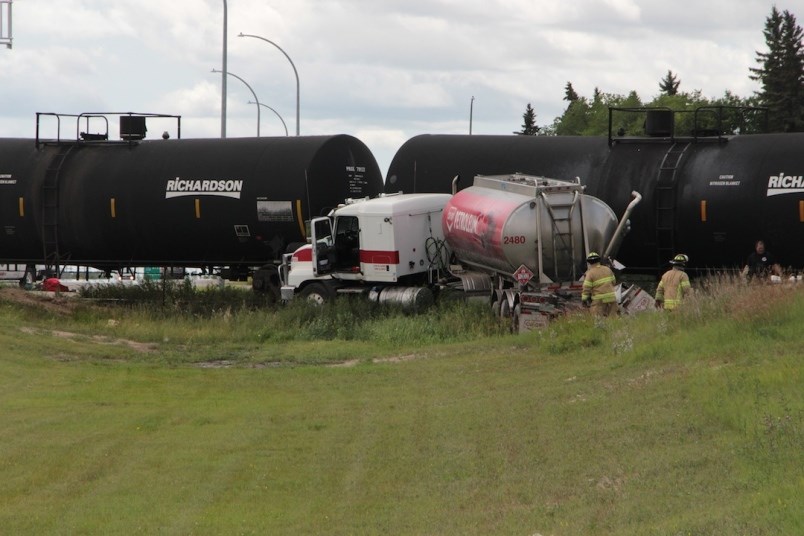At its regular meeting Monday Yorkton Council was given a presentation on rail safety as a shared responsibility.
ŌĆ£Canada╠²grew╠²up╠²along╠²the╠²railroad,ŌĆØ began Fire Chief Trevor Morrissey.
ŌĆ£T│¾┤Ū▓§▒╠²Ę╔│¾┤Ū╠²Ę╔┤Ū░∙░ņ╠²Š▒▓į╠²│┘│¾▒╠²░∙▓╣Š▒▒¶Ę╔▓╣▓Ō╠²Š▒▓į╗Õ│▄▓§│┘░∙▓Ō╠²▓╣░∙▒╠²Š▒│Š│Š▒▓į▓§▒▒¶▓Ō╠²▒Ķ░∙┤Ū│▄╗Õ╠²┤Ū┤┌╠²│┘│¾▓╣│┘╠²▒¶▒▓Ą▓╣│”▓Ō,╠²▓╣▓į╗Õ╠²│┘│¾▒Š▒░∙╠²│”┤Ū▓į│┘░∙Š▒▓·│▄│┘Š▒┤Ū▓į╠²│┘┤Ū╠²│┘│¾▒╠²▒│”┤Ū▓į┤Ū│ŠŠ▒│”╠²╗Õ▒▒╣▒▒¶┤Ū▒Ķ│Š▒▓į│┘╠²┤Ū┤┌╠²│¾│▄▓į╗Õ░∙▒╗Õ▓§╠²┤Ū┤┌╠²│┘┤ŪĘ╔▓į▓§╠²▓╣▓į╗Õ╠²│”Š▒│┘Š▒▒▓§,╠²▒¶▓╣░∙▓Ą▒╠²▓╣▓į╗Õ╠²▓§│Š▓╣▒¶▒¶,╠²▓╣│”░∙┤Ū▓§▓§╠²│┘│¾Š▒▓§╠²│”┤Ū│▄▓į│┘░∙▓Ō.╠²
As Canada has grown and its population increased, the rail industry shares a common challenge with those communities ŌĆō to significantly improve rail safety.╠²
Each year, approximately 250 Canadians are involved in railway crossing or trespassing incidents that can result in fatalities, or serious injuries. Virtually every one of those incidents is preventable.ŌĆØ
So how are accidents best prevented?
Through awareness campaigns. Through enforcement. And through a perspective that CN, North AmericaŌĆÖs only transcontinental railway, called ŌĆśChange Your Train of ThoughtŌĆÖŌĆØ, suggested Morrissey.
ŌĆ£It basically means that rail safety in Canada needs to become an accepted shared responsibility, and that we canŌĆÖt wait for a moment be complacent, or even hold for a second the notion that accidents just happen,ŌĆØ he said.
Rail Safety Week is just past, noted Morrissey, where a series of programs and events across Canada and the US emphasized the need for safe, responsible behaviour near railroad tracks.
Morrissey added trespassing on railway property is illegal, and a serious public safety issue.
ŌĆ£That was recognized in a comprehensive report, Enhancing Rail Safety in Canada: Working Together for a Safer Community,ŌĆØ he said. ŌĆ£It was prepared by an expert review panel and presented to federal Transport Minister Marc Garneau in May 2018. One of the reportŌĆÖs 16 recommendations called for a national strategy to reduce the number of fatalities and injuries that result from trespassing on railway property.
Proximity issues have been long been, and remain, the biggest cause of death and serious injuries in rail transportation ŌĆō 2,200 deaths and injuries in North America annually, offered Morrissey.
ŌĆ£In Canada, accidents at grade crossings and trespassing on railway properties account for over 90 per cent of all fatalities,ŌĆØ he said.
There are approximately 23,000 grade crossings across the country ŌĆō of which 14,000 public and 9,000 private ŌĆō according to the Enhancing Rail Safety in Canada report. Those crossings are under the authority of more than 3,000 municipal, provincial, territorial and federal authorities and Indigenous Groups, thousands of private land owners, and 32 railway companies, noted Morrissey.
ŌĆ£In recommending that Transport Canada develop a comprehensive national initiative to improve grade crossing safety, the report noted that other countries are closing grade crossings, and, when feasible, replacing them with grade separations,ŌĆØ he said.
And thatŌĆÖs expensive. It can cost $20 million to build a simple grade separation in a rural area, and more than $60 million in an urban setting.
ŌĆ£ItŌĆÖs going to take time, money ŌĆō and cooperation, all of which can only be achieved through partnership, and having everyone take on their role,ŌĆØ said Morrissey.
Development close to rail lines can be an issue too.
ŌĆ£The fact that Canada has grown up around the railroad has produced prosperity, but also challenges,ŌĆØ said Morrissey.
ŌĆ£Too often, residential, commercial and industrial development takes place too close to rail lines, creating safety concerns.ŌĆØ
The Federation of Canadian Municipalities (FCM) and the Railway Association of Canada (RAC) have long worked to find a balance, noted Morrissey.
In 2013, the FCM/RAC partnership led to the development of Proximity Guidelines, key policies for land use planning near rail lines infrastructure. The RAC estimates that 60 Canadian municipalities have adopted all or some of the Guidelines, and itŌĆÖs recommended that the Minister of Transport direct provincial transportation ministers to fully adopt them ŌĆō including a mandatory setback for any new development of at least 30 metres from any rail operation, he said.
ŌĆ£That would make for safer communities,ŌĆØ said Morrissey.
╠²




